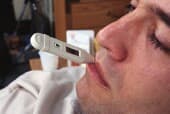Yearly testing will prevent some lung cancer deaths, experts conclude
WebMD News from HealthDay

By Dennis Thompson
HealthDay Reporter
MONDAY, Dec. 30, 2013 (HealthDay News) -- A highly influential government panel of experts says that older smokers at high risk of lung cancer should receive annual low-dose CT scans to help detect and possibly prevent the spread of the fatal disease.
In its final word on the issue published Dec. 30, the U.S. Preventive Services Task Force (USPSTF) concluded that the benefits to a very specific segment of smokers outweigh the risks involved in receiving the annual scans, said co-vice chair Dr. Michael LeFevre, a distinguished professor of family medicine at the University of Missouri.
Specifically, the task force recommended annual low-dose CT scans for current and former smokers aged 55 to 80 with at least a 30 "pack-year" history of smoking who have had a cigarette sometime within the last 15 years. The person also should be generally healthy and a good candidate for surgery should cancer be found, LeFevre said.
About 20,000 of the United States' nearly 160,000 annual lung cancer deaths could be prevented if doctors follow these screening guidelines, LeFevre said when the panel first proposed the recommendations in July. Lung cancer found in its earliest stage is 80 percent curable, usually by surgical removal of the tumor.
"That's a lot of people, and we feel it's worth it, but there will still be a lot more people dying from lung cancer," LeFevre said. "That's why the most important way to prevent lung cancer will continue to be to convince smokers to quit."
Pack years are determined by multiplying the number of packs smoked daily by the number of years a person has smoked. For example, a person who has smoked two packs a day for 15 years has 30 pack years, as has a person who has smoked a pack a day for 30 years.
The USPSTF drew up the recommendation after a thorough review of previous research, and published them online Dec. 30 in the Annals of Internal Medicine.
"I think they did a very good analysis of looking at the pros and cons, the harms and benefits," Dr. Albert Rizzo, immediate past chair of the national board of directors of the American Lung Association, said at the time the draft recommendations were published in July. "They looked at a balance of where we can get the best bang for our buck."
The USPSTF is an independent volunteer panel of national health experts who issue evidence-based recommendations on clinical services intended to detect and prevent illness.
The task force has previously ruled on mammography, PSA testing and other types of screening. It reports to the U.S. Congress every year and its recommendations often serve as a basis for federal health care policy. Insurance companies often follow USPSTF recommendations as well.
source : U.S. Panel Backs Routine Lung CT Scans for Older, Heavy Smokers















